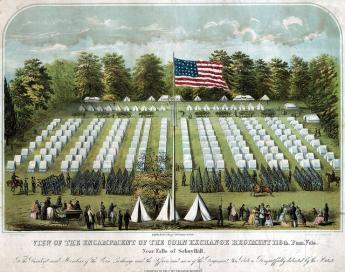Related Topics
The British Attack Philadelphia
Fighting in the Revolutionary War lasted eight years; for two years (June 1776 to June 1778) Philadelphia was the main military objective of the British.
Particular Sights to See:Center City
Taxi drivers tell tourists that Center City is a "shining city on a hill". During the Industrial Era, the city almost urbanized out to the county line, and then retreated. Right now, the urban center is surrounded by a semi-deserted ring of former factories.
City of Rivers and Rivulets
Philadelphia has always been defined by the waters that surround it.
Touring Philadelphia's Western Regions
Philadelpia County had two hundred farms in 1950, but is now thickly settled in all directions. Western regions along the Schuylkill are still spread out somewhat; with many historic estates.
The Main Line
Like all cities, Philadelphia is filling in and choking up with subdivisions and development, in all directions from the center. The last place to fill up is the Welsh Barony, a tip of which can be said to extend all the way in town to the Art Museum.
Pacifist Pennsylvania, Invaded Many Times
Pennsylvania was founded as a pacifist utopia, and currently regards itself as protected by vast oceans. But Pennsylvania has been seriously invaded at least six times.
George Washington in Philadelphia
Philadelphia remains slightly miffed that Washington was so enthusiastic about moving the nation's capital next to his home on the Potomac. The fact remains that the era of Washington's eminence was Philadelphia's era; for thirty years Washington and Philadelphia dominated affairs.
Revolution in New Jersey
Early, brief but significant.
Encampment At East Falls
The urban intersection at Queen Lane and Fox Avenue in East Falls is a busy one, and except for a few stately residences, it easily escapes notice by commuters. However, the landscape forms a bowl atop a steep hill, fairly near the Schuylkill River. George Washington had evidently picked it out as a strong military position near the Capital at Philadelphia, either to defend the city or from which to attack it, as circumstances might dictate.

|
| Encampment at East Falls |
Washington's plans and thought processes are not precisely recorded, but when Lord Howe had sailed south from the Staten Island- New Brunswick area, he ordered his troops to head for an East Falls encampment at the southern edge of Germantown. Crossing the Delaware River at Coryell's Ferry (New Hope), the troops marched inland a few miles and then down the Old York Road to this encampment. Their stay at the beginning of August 1777 was quite brief because Washington changed his mind. When it took Howe's fleet longer than expected to appear in the Chesapeake, Washington became uneasy that Howe might be conducting a feint designed to draw the Continental troops south, and after cruising around the coast, might still return to attack down the undefended New Jersey corridor from Perth Amboy to Trenton. That proved wrong, but in Washington's defense, it must be said it was a plan that had actually been considered by the British. Anyway, Washington ordered his troops to pull out of the East Falls encampment and march back up Old York Road to Coryell's Crossing, which would be a more central place to keep his options open for the time when Howe's true intentions became clear. Washington and his headquarters staff went on ahead of the main body of troops, setting up headquarters at John Moland's House a little beyond Hatboro and a few miles west of Newtown, Buck's County. The Hatboro area was a pocket of Scotch-Irish settlement, without any local Tory sentiment, thus preferable to the rest of largely Quaker Buck's County.
To jump ahead chronologically, the East Falls encampment site must have seemed agreeable to the Continental Army, because a few weeks later it would be sought out as the main refuge and regrouping area, following the defeat at the Battle of Brandywine. The American troops were to withdraw from the Brandywine Creek when Washington realized he had been out-flanked, and head for Chester. Quickly recognizing that Chester was vulnerable, they headed for East Falls. Not only was Washington preparing to defend Philadelphia at that point, but was using the Schuylkill River as a defense barrier. As he had earlier done at the Battle of Trenton, he ordered all boats removed from the riverbanks, and artillery placed at any likely fording places, all the way up the Schuylkill to Norristown. Having accomplished that, this extraordinary guerrilla fighter then moved his troops from Germantown up the river to defend the fords. Meanwhile, Congress decided to move to the town of York on the Susquehanna, just in case.
Originally published: Friday, June 23, 2006; most-recently modified: Monday, May 20, 2019
| Posted by: followers exchange tool | Feb 13, 2012 9:57 AM |
| Posted by: cheapostay | Feb 13, 2012 9:35 AM |
| Posted by: esalerugs | Feb 13, 2012 9:13 AM |